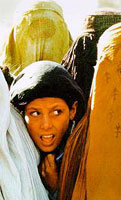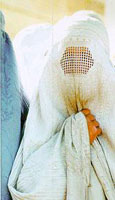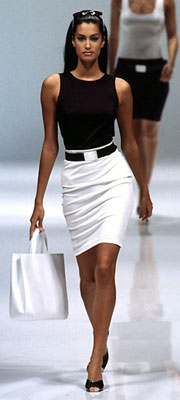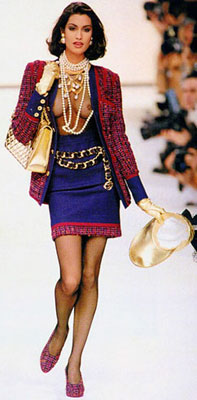SILENCE OF THE BURQA
Mohammed A. Qadeer
[Mohammed A. Qadeer is a professor of urban planning at
Queen's University in Kingston, Ontario.] Ed.
 I
did a double-take upon running into two women covered from head to toe in two-piece
black burqas, faces veiled by their see-through hoods, in downtown Montreal.
I felt disoriented on the first take. It was a scene from the distant past.
For a split second, I was not sure of my bearings. Where was I? What year was
it? I was surprised, dismayed and exasperated at the same time.
I
did a double-take upon running into two women covered from head to toe in two-piece
black burqas, faces veiled by their see-through hoods, in downtown Montreal.
I felt disoriented on the first take. It was a scene from the distant past.
For a split second, I was not sure of my bearings. Where was I? What year was
it? I was surprised, dismayed and exasperated at the same time.
It was because I knew all about the custom of women wearing
burqas and veiling their faces. At one time, my mother and sister wore burqas.
In the Lahore of my youth, the two-piece black satin burqas
came into vogue in the 1950s. It was a fashion statement, a symbol of progress
and liberation for women. The two-piece burqas displaced the 'white-tent' or
'shuttlecock' burqas which wrapped women in a cloak, with only a screened slit
for an eyepiece (as Afghan women are compelled to wear these days).
 The
black burqa liberated women, allowing them to move about in their own silhouette,
freeing them from the confines of a moving bubble, Its fitted form and prospects
of peekaboo were the mark of a Muslim Woman's modernity in the 1950s. It introduced
style and fashion in the veiling of women and thus began the process of their
gradual unveiling.
The
black burqa liberated women, allowing them to move about in their own silhouette,
freeing them from the confines of a moving bubble, Its fitted form and prospects
of peekaboo were the mark of a Muslim Woman's modernity in the 1950s. It introduced
style and fashion in the veiling of women and thus began the process of their
gradual unveiling.
By the 1970s, burqas had disappeared, except in some villages
and among conservative urban families.
The black burqas were reminders of a bygone era, at least for
me. I presumed that the two burqa-clad women were Muslims and were following
their customary practice of veiling in public. But for me, a Muslim, they symbolized
women's retreat from the public space. The black burqas, which originally freed
women from their traditional confinement, were being used to assert Muslim women's
withdrawal from the public space in Montreal.
 But
instead of protecting women from male gaze, the burqas drew attention and aroused
curiosity. Everybody was gawking at the two veiled women.
But
instead of protecting women from male gaze, the burqas drew attention and aroused
curiosity. Everybody was gawking at the two veiled women.
I could not help arguing with myself about the custom of veiling
the face. I thought, "Is it not incongruous to choose to live in Canada
but wear veils? Why did these women migrate here? Would they not have been more
comfortable back home?
"In colonial times, a Muslim princess from India was rumored
to have been arrested in London for endangering public safety by covering her
face. Could this happen in Canada?"
And the counterpoint: "Why shouldn't they wear veils if
they freely wish to do so? They can dress as they like. It's up to them. Their
veils do not interfere with others' well-being.
"Don't Canadian freedoms include the right to follow one's
conscience and taste in dress, within bounds of decency and morality? If men
in spandex shorts, women in halter tops or both with Nazi tattoos or pierced
belly buttons are free to dress as they like, why pick on veils? If baring is
acceptable, why shouldn't covering up be?"
Yet again. "Ah, but veiling is an oppressive custom. It
enslaves women. It also perpetuates Western biases against Muslims and reinforces
stereotypes of women's subordination in Islam.
"Why bring customs to Canada that are disappearing even
in the lands of their origin? Why muddy Islam?
"The Hijab, as now interpreted, only requires head scarves
and coveralls but no veils. Veiling faces is essentially a matter of local custom
in particular communities or regions. Veils are not an essential Islamic practice."
 This
debate in my head diffused my exasperation, leaving me to ponder over the sociological
implications of veils in Canada.
This
debate in my head diffused my exasperation, leaving me to ponder over the sociological
implications of veils in Canada.
The two burqa-clad women in Montreal were not the object of
my exasperation. Perhaps they were also victims of some outdated custom. What
is intriguing is the silence of Muslim communities over this practice, which
most of them would not consider to be a religious requirement.
A broader issue is the generally conservative nature of immigrant
communities in religious and cultural matters.
Why, for example, do Canadian Muslims, comprised of immigrants
from scores of countries, tend to lean toward orthodox beliefs and customary
religious practices, in contrast with their openness to new ways of life in
economic, social and educational spheres? They revive practices that they probably
would not have followed had they stayed back home. Why haven't Muslim communities
done away with veils?
I wonder if the silence is a defensive response to the persisting
stereotyping of Muslims in Canadian media. Yet Muslims and other immigrant communities
should not be trapped by these stereotypes. They should organize their community
life in the idiom of multicultural Canada and not just in a reactive mode. They
should proactively promote their own progressive mores in public behavior and
dress. Burqas should concern the Muslim communities and not the Canadian state.
THE END
Voice Your Opinion
- Back to
the Table of Contents - HOME
 I
did a double-take upon running into two women covered from head to toe in two-piece
black burqas, faces veiled by their see-through hoods, in downtown Montreal.
I felt disoriented on the first take. It was a scene from the distant past.
For a split second, I was not sure of my bearings. Where was I? What year was
it? I was surprised, dismayed and exasperated at the same time.
I
did a double-take upon running into two women covered from head to toe in two-piece
black burqas, faces veiled by their see-through hoods, in downtown Montreal.
I felt disoriented on the first take. It was a scene from the distant past.
For a split second, I was not sure of my bearings. Where was I? What year was
it? I was surprised, dismayed and exasperated at the same time. The
black burqa liberated women, allowing them to move about in their own silhouette,
freeing them from the confines of a moving bubble, Its fitted form and prospects
of peekaboo were the mark of a Muslim Woman's modernity in the 1950s. It introduced
style and fashion in the veiling of women and thus began the process of their
gradual unveiling.
The
black burqa liberated women, allowing them to move about in their own silhouette,
freeing them from the confines of a moving bubble, Its fitted form and prospects
of peekaboo were the mark of a Muslim Woman's modernity in the 1950s. It introduced
style and fashion in the veiling of women and thus began the process of their
gradual unveiling.  But
instead of protecting women from male gaze, the burqas drew attention and aroused
curiosity. Everybody was gawking at the two veiled women.
But
instead of protecting women from male gaze, the burqas drew attention and aroused
curiosity. Everybody was gawking at the two veiled women.  This
debate in my head diffused my exasperation, leaving me to ponder over the sociological
implications of veils in Canada.
This
debate in my head diffused my exasperation, leaving me to ponder over the sociological
implications of veils in Canada.